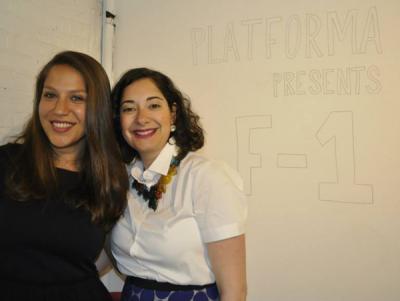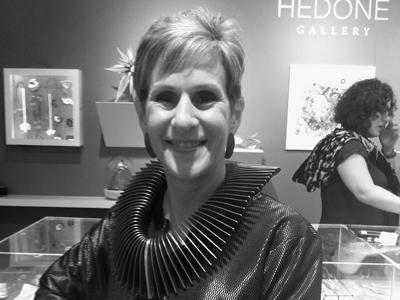
Bonnie Levine: Platforma is a newly established curatorial initiative established by the two of you. Can you tell us about it—what is its mission and why did you feel the need to start it?
Bella Neyman: Platforma was launched over a cup of coffee last summer. Ruta and I both wanted to create a new venue through which to show art jewelry and, like everyone else in this business, we want to get in front of young collectors. Artists, especially emerging ones, need the support of clients to survive and we want to play a role in helping the field grow and prosper. Our mission is to breathe new life into the field through pop-up exhibitions and events and amass a following that will be interested in what we have to say and in the work that we are showing. As we do not have a permanent space, we feel like we can take chances and experiment with what we are showing and how we choose to show it. Furthermore, as we want to entice young collectors to fall in love with art jewelry we also want to try to educate them.

Bonnie Levine: Platforma is a newly established curatorial initiative established by the two of you. Can you tell us about it—what is its mission and why did you feel the need to start it?
Bella Neyman: Platforma was launched over a cup of coffee last summer. Ruta and I both wanted to create a new venue through which to show art jewelry and, like everyone else in this business, we want to get in front of young collectors. Artists, especially emerging ones, need the support of clients to survive and we want to play a role in helping the field grow and prosper. Our mission is to breathe new life into the field through pop-up exhibitions and events and amass a following that will be interested in what we have to say and in the work that we are showing. As we do not have a permanent space, we feel like we can take chances and experiment with what we are showing and how we choose to show it. Furthermore, as we want to entice young collectors to fall in love with art jewelry we also want to try to educate them.
Ruta Reifen: It was actually coffee and French fries. We were mystified as to why art jewelry isn’t a prominent art field or curious to more art appreciators. Platforma’s main objective is to promote art jewelry as the meaningful and relevant art practice that it is to a wider audience. Our mission is to present art jewelry in alternative ways, embracing its “in-between” status and bridging art, fashion, and design. And we want to complement existing art jewelry galleries and publications by remaining as a project-based initiative, by staging pop-ups; themed, curated exhibitions; and short-term events. We hope that in this way we can reach more collectors.

F-1: A Jewelry Exhibition is the first project of Platforma. What was the impetus for the show? What does F-1 refer to?

Ruta Reifen: I came to the States on an F-1 visa for my MFA studies at the Rhode Island School of Design. It is a great commonality between artists creating in the States. As a theme, it allowed us to examine the field as it exists nationally and internationally at once.
I love the show’s by-line: foreigners living the American jewelry dream. Why are increasing numbers of students coming here to study and perhaps remain here to pursue their careers? Are there common themes you’ve observed in your interactions with these emerging artists?
Bella Neyman: America is the land of opportunity. According to the census (as written about by Jennifer Navva Milliken in the exhibition catalog), during the fiscal year of 2012, 486,900 F-1 visas were issued by the United States Citizen and Immigration Services, an increase of over 100,000 from 2010 and over 250,000 from 2004. Most of our artists came to the U.S. on an F-1 to get either their MFA or BFA. And for some, it gave them the chance to remain in this country and pursue jewelry making as a second career.

As you point out, the number of F-1 visas has grown exponentially in recent years. Do you think there’s anything unique about contemporary art jewelry that attracts students here to study and pursue their dreams?
Ruta Reifen: Contemporary art jewelry is far more acceptable as a study major and studio practice in Europe than in the States. There are ancient traditions that already evolved to modern approaches in Europe. Many more schools offer jewelry studies and apprenticeships. There are many contemporary jewelry galleries, and the largest collections and most important annual shows are all in Europe. This positions American academia as a hidden gem, yet to be fully explored. There’s a sense of urgency to prove quality and relevance by the institutions. As an Israeli, I can highly relate to this notion. Students find this attractive, liberating and challenging—there’s more room to grow.

Bella Neyman: I was very young when my family brought me here and for me, there is no going back. My family has influenced my career by exposing me to the arts and supporting my desire to become a design historian and putting me through graduate school. They never said no to me.
Ruta Reifen: I’m currently preparing for my first solo exhibition, All is Dvash, that opens in July, 2014, at Sienna Gallery (Lenox, Massachusetts). My work is more narrative than ever, clearly an influence of studying and working in the States. Of course there are elements that are native to me, mostly in concept; formally, it is totally American (as perceived by a foreigner). These two sides that coexist in my work are part of my everyday life. I am thankful for the incredible education I received here, the wonderful and supportive art jewelry community that barely exists in my homeland. Having a studio in Brooklyn and access to the Big Apple (New York City) is a dream. However, I’m an alien here, far from home and family. “My heart is in the East, and I am at the ends of the West.” (Yehuda Halevi, circa 1130)
As a jewelry artist and a design historian/journalist, what have you seen or read recently that you’d like to share with us?
Bella Neyman: My problem is that I see too many things! Most recently I visited the Paul Evans retrospective at the Michener Museum in Doylestown, Pennsylvania, and the Charles James retrospective at the Metropolitan Museum of Art. Interestingly enough, both Paul Evans and Charles James tried their hand at making jewelry. While the pieces weren’t incredibly exciting as stand-alone objects, it was interesting to see how they fit into their oeuvre. Some of the sculptural elements that Evans used in his forged-front consoles in the mid 1960s have origins in miniature as a brooch and pendant in the early 1950s. James’s jewelry maquettes from around the same time (1955–1965) consisted of bows that are full and vivacious, resembling the lines in some of the wool skirts (circa early 1960s) that are on view in the show.
Ruta Reifen: André Gali reflects on several recent critical writings in “After the End of Contemporary Jewelry”, in Norwegian Crafts magazine. He concludes as Platforma would, with optimism. We now have a golden opportunity to redefine ourselves, strengthen our place. Platforma is out to do exactly that.
Thank you.




